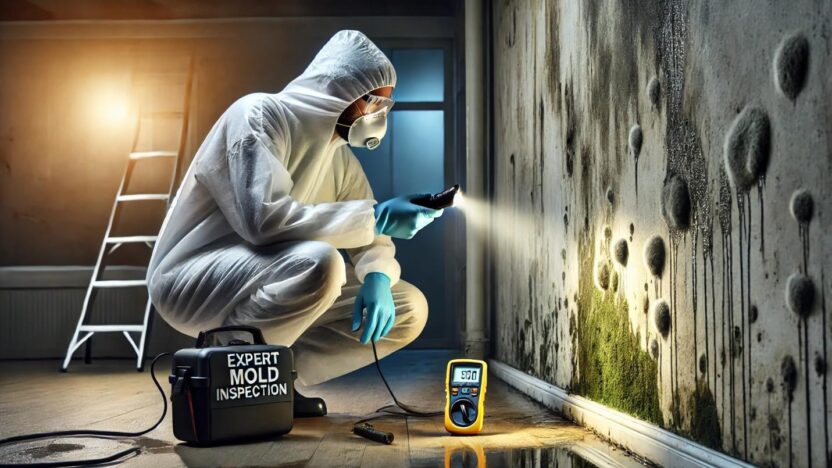The black mold can cause serious concern, and understandably so. This type of mold is known to be toxic and commonly thrives in damp, dark areas of homes, especially following water damage or periods of high humidity. When black mold is discovered, homeowners often face an important decision: Is it safe to handle mold removal yourself, or should you seek professional assistance?
In this post, we’ll explore the dangers of removing mold on your own, discuss situations where DIY might be safe, and explain when it’s best to bring in a licensed expert.
What Is Black Mold?
Black mold, also referred to as Stachybotrys chartarum, is a potentially harmful type of fungus that grows in damp, poorly ventilated areas like basements, bathrooms, or places affected by water leaks. It can produce toxic compounds called mycotoxins, which may pose health risks to both people and pets through contact or inhalation.
Common Symptoms of Black Mold Exposure:
- Persistent cough or frequent sneezing
- Red, itchy, or watery eyes; nasal or throat irritation
- Unexplained skin irritation or rashes
- Ongoing headaches or migraines
- Feeling unusually tired or mentally sluggish
- Increased sensitivity or flare-ups in asthma or allergies
Can You Clean Black Mold Yourself?
Yes, but only under certain conditions. The Environmental Protection Agency (EPA) recommends that homeowners can safely remove mold themselves if the affected area covers less than 10 square feet and if they have no underlying respiratory health issues. If you attempt to clean black mold yourself, just be sure to take proper precautions.
When DIY Mold Cleaning May Be Safe:
- The mold growth is confined to a small, limited space.
- The affected surface is non-porous, such as tile or glass.
- There’s no noticeable mold odor or signs of deeper mold behind the surface.
- You’re equipped with appropriate safety gear, including a mask, gloves, and protective eyewear.
DIY Mold Cleaning Steps
If you’re tackling a small mold patch, follow these steps carefully:
1. Wear Proper Protective Gear
- N95 mask or respirator.
- Rubber gloves.
- Eye goggles.
- Old clothing you can discard or wash in hot water.
2. Use a Safe Cleaning Solution
- White vinegar (undiluted).
- Hydrogen peroxide (3%).
- Mix baking soda and water.
- Commercial mold remover.
3. Scrub the Mold Thoroughly
- Apply to your cleaner’s office.
- Let it sit for at least 10 minutes.
- Scrub with a stiff brush.
- Rinse and dry the area completely.
4. Dispose of Cleaning Materials Safely
- Double-bag used rags and sponges.
- Wash clothing in hot water.
- Sanitize all tools used.
When You Should Call Mold Remediation Experts
There are several scenarios where DIY is not safe or effective, and professional mold remediation is the only smart option.
Call a Mold Expert If:
- The mold covers more than 10 square feet.
- You notice strong musty odors.
- Mold keeps coming back after cleaning.
- The affected surface is porous, like drywall or insulation.
- You have health symptoms that could be mold related.
- The mold is near your HVAC system or in air vents.
- You’ve had recent flooding or water damage.
Risks of DIY Mold Removal
Cleaning mold without proper precautions can be risky. Here’s why:
- Spore Spread: Attempting to clean mold yourself can release spores into the air, spreading the problem to other parts of your home.
- Ineffective Products: Many DIY cleaners don’t eliminate mold at its roots, allowing it to grow back.
- Health Hazards: Mold exposure can cause serious health issues, especially for those with allergies, asthma, or weakened immune systems.
- Hidden Growth: Incomplete cleaning may leave mold behind walls, under floors, or in other hidden areas, where it can continue to thrive unnoticed.
How Professionals Remove Black Mold Safely
Here’s what experts do that you likely can’t on your own:
- Perform mold testing and air quality checks.
- Isolate the affected area to prevent cross-contamination.
- Use commercial-grade HEPA filters and vacuums.
- Remove and replace contaminated materials safely.
- Identify and fix the source of moisture to prevent future growth.
Final Thoughts
Black mold is not something to take lightly. While small, surface-level patches can often be handled safely with the right precautions, larger or hidden infestations require professional attention. Cleaning black mold improperly may lead to exposure, regrowth, and hidden damage. For anything beyond a small, surface-level issue, it’s wise to call in professionals who can ensure safe and thorough removal. When in doubt, it’s always safer to consult a certified mold remediation specialist who can ensure the job is done thoroughly and safely.
FAQs
1. Is it safe to clean black mold yourself?
Yes, but only if the affected area is small (under 10 square feet), on non-porous surfaces, and you have no respiratory issues. Always wear protective gear and ensure proper ventilation.
2. What are the risks of cleaning black mold without professional help?
Improper cleaning can spread mold spores, worsen health symptoms, and fail to address hidden mold or moisture sources, leading to recurring problems.
3. When should I call a professional for black mold removal?
Call an expert if the mold covers a large area, is hidden behind walls or in HVAC systems, keeps returning, or if anyone in the home has health concerns.



